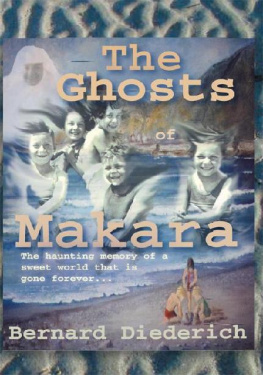SEEDS OF FICTION
In 1965 Graham Greene made what he described as a trip down the Dominican and Haitian border in the company of two exiles from Haiti. Bernard Diederich was one of those two exiles, and Seeds of Fiction includes a first-hand account of that trip, one that inspired one of Greenes most significant works, The Comedians.
Diederich, a seasoned correspondent for the British and North American press, had lived in Haiti for many years. In 1963 he had been thrown out by Papa Doc Duvalier, and, in exile in the neighbouring Dominican Republic, soon became a champion of the cause of the Haitian opposition.
Diederich and Greene had become friends in the mid-1950s when the celebrated author visited Haiti. When Greene met Diederich in Santo Domingo in 1965 he was sixty-one and depressed and plagued by religious doubt. Sensing that the volatile political situation in Haiti was something Greene could write about and so help to expose the Duvalier regime in all its brutality, Diederich suggested they tour the border region between the two countries, and together with an exiled Haitian priest, Fr Jean-Claude Bajeux whose family had recently been disappeared they set off. Along the way they met a number of characters later fictionalized in Greenes most politically charged novel, The Comedians, and Seeds of Fiction illuminates in detail this pivotal episode in Greenes career and provides a fascinating glimpse into the writers life from a very personal perspective.
Diederich arranged for Greene to visit Panama and to meet its leader Omar Torrijos, and a friendship quickly developed between the two men, with Greene making a number of trips to visit Torrijos and to get to know the region. This formed the background to Getting To Know the General, Greenes seminal work on the situation in Central America at that time. These journeys and Greenes relationship with Torrijos are also explored in intimate detail in this book everything from where to get the best rum punches to Greenes views on US policies in the region.
With extensive new material and exclusive, never-before-seen photographs of the author on his travels, Seeds of Fiction tells the story of how a series of extraordinary and often hair-raising journeys gave one of the greatest novelists of the twentieth century new inspiration in his writing.

BERNARD DIEDERICH was born in New Zealand and settled in Haiti in 1949. The following year he set up an English-language weekly newspaper, the Haiti Sun, and became the resident correspondent for the Associated Press, the New York Times, the Time-Life News Service and the Daily Telegraph. Exiled from Haiti in 1963 by Papa Doc Duvalier, he settled in the Dominican Republic and concentrated on his career in journalism. Later postings for Time magazine included Mexico City and Miami, and his close encounters with dictators and death provided an abundance of news covering coups, revolutions, invasions, earthquakes, hurricanes and volcanic eruptions as well as a wealth of material for his books about the politics and political leaders of the Caribbean and Central America. Diederich was finally allowed to return to Haiti in 1980 to interview Baby Doc Duvalier and his new wife Michle, and he was then able to report on the popular uprising that sent them both into exile in 1986. He now splits his time between Miami and Port-au-Prince, Haiti. It was in the Haitian capital in 1954 that Diederich first met Graham Greene, and this led to a life-long friendship much of it based on a shared love of that country which only ended with Greenes death in 1991.
| ACKNOWLEDGEMENTS
Graham Greenes niece and last secretary, the late Amanda Dennys Saunders, was the first person to encourage me to write this book. She was an inspiration, and I owe dear Amanda, her husband Ron and daughter Lucy much gratitude. Yvonne Cloetta, Grahams companion, had cheered me on in spite of being a target of malicious attacks and did not live to read the book.
There are many who helped me along the road to telling the story of a man who over the years had become a father figure and to whom I turned for advice, which I treasured. I wish to thank Graham Greenes Estate, and especially Francis, for permitting me to use my correspondence with his father. As a compulsive note-taker as was Graham I recorded the dialogue between Graham and myself for stories, some published and others shelved, but to this day I can recall our journeys together.
There are many I must thank, beginning with our writer son Phillippe, my editor, who deserves credit for making me break with my long-held view that a journalist should not become the story and who weeded out so many distracting details that had overloaded earlier versions of this book. I also thank my son Jean-Bernard, who was privileged to know Graham and several of the photographs he took during our last visit to Graham appear in this book and, of course, my wife of fifty years who put up with my bringing dictators into our various homes and courageously faced several of them down.
Professor Richard Greene (no relation) wrote the book Graham Greene: A Life in Letters that is among the best editing of Grahams correspondence. The late Peter Glenville, although retired, was forthcoming in his interview with me. Haitis Foreign Minister, Franois Benot, allowed me to photocopy the Ministrys only remaining copy of Graham Greene Dmasqu a 92-page Haiti Foreign Ministry bulletin that turned to dust in the January 2010 earthquake. Tel Scott of the Havana Post had kept me informed of Grahams 1954 antics in Havana. Reverend Jim McSwigan, in charge of the Redemptorist Mission Home at Las Matas de Farfn, saved us from dying of thirst on our border trip in January 1965. I would also like to thank the lawyer Sauveur Vaisse for being generous with his time in a Paris interview in 1986.
In Haiti there are so many to whom I am indebted peasant neighbours, fellow journalists, Haitians of all ranks of society and our extended family. As a journalist I needed to break the heavy hand of Papa Docs censors to send my stories out to the world. Among those who took great risks were RCA Cable employees, especially Josseline Bazelais Edline at West Indies Cable, the only international telephone company. My friend the late Albert Silvera, the owner of El Rancho Hotel, kept me informed of Graham movements during his 1954 and 1956 visits. The late Aubelin Jolicoeur was a great asset to my newspaper, the Haiti Sun; he liked to embroider his stories about Graham during his three visits to Haiti but was nevertheless a good witness. My friend Dick Eder of the New York Times was a superb journalist whose story on Graham in Haiti in 1963 was loved by all. Manny Freedman, Foreign Editor of the New York Times, wanted to know whether I had become a guerrilla when I was among the Kamoken denounced to the United Nations Security Council by Papa Doc but accepted my reasoning that a journalist must go to extremes sometimes to get the story. Mambo Lolotte was understanding and showed great kindness in arranging a red cushion and miniature rocking-chair for Grahams bottle of vodka.
I am indebted to my employers at Time-Life News Service (TLNS), who understood the importance of my close ties to General Omar Torrijos, not only because Panama was a major story but also because of Torrijoss knowledge of the crisis in Central America. They also knew that my time with Graham Greene produced stories. Editor-in-Chief Hedley Donovan, whose visit with other Time notables to Panama I had to arrange, produced an excellent editorial on South America that is quoted here. John Dingess excellent book
Next page










